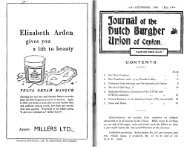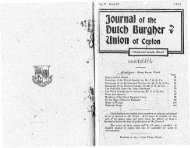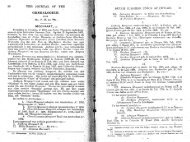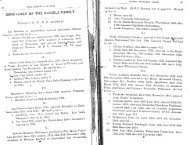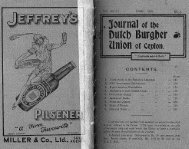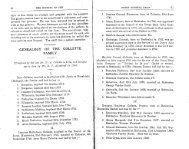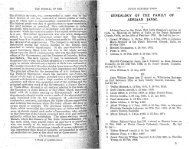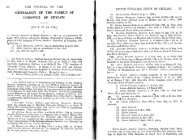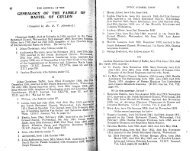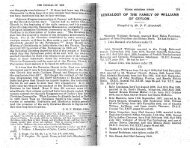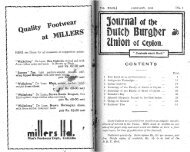genealogy of the family of hass%l- meyer of ceylon. - Dutch Burgher ...
genealogy of the family of hass%l- meyer of ceylon. - Dutch Burgher ...
genealogy of the family of hass%l- meyer of ceylon. - Dutch Burgher ...
Create successful ePaper yourself
Turn your PDF publications into a flip-book with our unique Google optimized e-Paper software.
90 THE JOURNAL OP THE<br />
serving for visitors imbued with antiquarian interest who may find<br />
<strong>the</strong>mselves in <strong>the</strong> nor<strong>the</strong>rn parts. Negombo had a church, and so<br />
had Batticaloa, but <strong>the</strong>y have disappeared.<br />
We next come to <strong>the</strong> old <strong>Dutch</strong> " Kerk<strong>of</strong>s " or burial grounds.<br />
No visitor to <strong>the</strong>se landmarks located at all important places in<br />
<strong>Dutch</strong> times can have failed to notice <strong>the</strong> carelessness and want <strong>of</strong><br />
reverence for <strong>the</strong>se memorials displayed by <strong>the</strong> successors and<br />
descendants <strong>of</strong> <strong>the</strong> <strong>Dutch</strong>. The easily portable head-stones have<br />
been removed; some have been cut up for building purposes and to<br />
pave <strong>the</strong> floors <strong>of</strong> private houses. O<strong>the</strong>rs served excellently as<br />
coverings for drains and for steps. Evidence is not wanting that<br />
<strong>the</strong>se <strong>Dutch</strong> tomb-stones were used for commemorating persons<br />
who died in <strong>the</strong> British period, by fresh inscriptions on <strong>the</strong> reverse<br />
<strong>of</strong> <strong>the</strong> stone. Many a stone set in brick-work, or used as mural tablets<br />
in churches, possibly have earlier <strong>Dutch</strong> inscriptions on <strong>the</strong><br />
back <strong>of</strong> <strong>the</strong>m.<br />
There are few <strong>Dutch</strong> buildings <strong>of</strong> <strong>the</strong> domestic type extant in<br />
Colombo. The last century saw <strong>the</strong> modernisation <strong>of</strong> many <strong>of</strong> <strong>the</strong>m.<br />
Afber much search only one <strong>of</strong> <strong>the</strong>m can be found in Chatham<br />
Street. In <strong>the</strong> Pettah, which remained a <strong>Dutch</strong> quarter longer than<br />
<strong>the</strong> Fort <strong>of</strong> Colombo, many distinctive features <strong>of</strong> <strong>the</strong> <strong>Dutch</strong> buildings<br />
were recently disclosed when demolition was effected to provide<br />
fire-gaps for <strong>the</strong> city. In Prince Street <strong>the</strong>re still stands <strong>the</strong> old<br />
<strong>Dutch</strong> Orphan House, now <strong>the</strong> Post Office. It is an unique relic <strong>of</strong><br />
<strong>the</strong> period.<br />
The only outstation town which is still redolent <strong>of</strong> <strong>the</strong> period<br />
in which it was a <strong>Dutch</strong> settlement is <strong>the</strong> Galle Port—narrow<br />
streets, wooden pillars, peculiar ornamental fanlights and doorway<br />
lintels, floors paved with large bricks, and <strong>the</strong> characteristic<br />
feature <strong>of</strong> <strong>Dutch</strong> colonial architecture, <strong>the</strong> gable, are still much in<br />
evidence.<br />
The seeker after relics <strong>of</strong> <strong>Dutch</strong> times in Bentota will find an,<br />
old church and school hall, still being used as a school. It has a<br />
history and an inscription. At Ambalangoda <strong>the</strong>re is ano<strong>the</strong>r<br />
church-school, now used partly as <strong>the</strong> Besthouse garage and partly<br />
as a Village Court. What is to be deplored is <strong>the</strong> fact that this<br />
building was paved with <strong>the</strong> grave stones <strong>of</strong> prominent personages<br />
who were buried <strong>the</strong>re. These possibly still lie below <strong>the</strong> present<br />
floor. It should be no great task to move <strong>the</strong>m to a place <strong>of</strong><br />
safety.<br />
For what was done in <strong>the</strong> past <strong>the</strong> gratitude <strong>of</strong> every member<br />
<strong>of</strong> our community must go out to <strong>the</strong> small band <strong>of</strong> Eevenue Officers<br />
who directed <strong>the</strong>ir energies to preserve <strong>the</strong> relics <strong>of</strong> <strong>the</strong> Portuguese<br />
and <strong>Dutch</strong> times by every possible means. Foremost among <strong>the</strong>m<br />
was J. P. IJawis. He left no <strong>Dutch</strong> monument unvisited, and essayed<br />
a great task indeed when he brought <strong>the</strong>m to <strong>the</strong> notice <strong>of</strong> <strong>the</strong><br />
public in his book "Tombstonesand Monuments in Ceylon."<br />
Sir Emerson Tennent referred to <strong>the</strong> Dutcja in Ceylon as an<br />
expiring community in Colombo". It is gratifying to know thft«<br />
DUTCH BU8GHEH UNION 91<br />
94 years after, this expiring community can view <strong>the</strong> memorials <strong>of</strong><br />
<strong>the</strong> <strong>Dutch</strong> period with a measure <strong>of</strong> interest. It is ridiculous to<br />
imagine that we can rectify <strong>the</strong> neglect <strong>of</strong> a century and a half in<br />
a decade or two. This work <strong>of</strong> conservation and preservation is one<br />
that will need <strong>the</strong> co-operation <strong>of</strong> generations. What is more, we<br />
must realise that <strong>the</strong>re will be cases where sentiment must give<br />
way to utility. There are alterations which must involve <strong>the</strong> dispersion<br />
<strong>of</strong> some <strong>of</strong> <strong>the</strong>se memorials, but happily that day when demolition-<br />
or accretion was left to <strong>the</strong> will and decision <strong>of</strong> persons<br />
who were not competent to decide, have passed away. We embark<br />
on a new era with much greater hope that <strong>the</strong> monuments <strong>of</strong> <strong>the</strong><br />
<strong>Dutch</strong> Period will find a place in imparting <strong>the</strong> history <strong>of</strong> Ceylon's<br />
past.<br />
GENEALOGY OF THE FAMILY OF HASS%L-<br />
MEYER OF CEYLON.<br />
{Compiled by Mr. D. V. Altendorff).<br />
I.<br />
Johannes Hazelmyer <strong>of</strong> Eyzerloon, Corporaal in <strong>the</strong> service <strong>of</strong><br />
<strong>the</strong> <strong>Dutch</strong> East India Company, married in <strong>the</strong> <strong>Dutch</strong> Reformed<br />
Church, Wolvendaal, 13th May 1770, Catharina Spaar, and he had<br />
by her:—<br />
1 Johannes, who follows under II.<br />
2 Maria Francina, married in <strong>the</strong> <strong>Dutch</strong> Reformed Church,<br />
Wolvendaal, 2nd May 1790, Jean Henry Batta <strong>of</strong> Deone,<br />
Soldaat in <strong>the</strong> <strong>Dutch</strong> East India Company. »<br />
II.<br />
Johannes Hazelmyer, baptised 5th May 1771, married in <strong>the</strong><br />
<strong>Dutch</strong> Reformed Church, Wolvendaal, 15th April 1810, Johanna<br />
Henriatta Matthysz, and he had by her ;—<br />
1 Joban Andreas Francois, who follows under III.<br />
"III.<br />
Johan Andreas Francois Hassel<strong>meyer</strong>. baptised 27th January<br />
1812, married in <strong>the</strong> <strong>Dutch</strong> Reformed Church, Wolvendaal, 11th<br />
May 1840, Anna Helena Ebert, baptised 9th October 1808, died 23rd<br />
January 1876, daughter <strong>of</strong> Roel<strong>of</strong>f Hendrik Ebert and Johanna<br />
Susanna de Waas. (D.B.TJ Journal, Vol. VI, page 78). He had by<br />
her:—<br />
1 Edmund Joseph, who follows under IV.<br />
2 Johanna Hendriatta, born 28tb April 1845, married in <strong>the</strong><br />
<strong>Dutch</strong> Reformed Church, Wolvendaal, 1st May 1865, Edwin<br />
Duncan Soerts, Head Clerk, Kachcheri, Galle, born 21st<br />
September 1843, son <strong>of</strong> Henricus Alexander Soerts and Elizabeth<br />
Henrietta Dourensz. (D>.B.U. Journal, Vol. VIII,<br />
page 71).
92 THE JOURNAL OP THK<br />
IV.<br />
Edmund Joseph Hassel<strong>meyer</strong>, born 16th April 184?, died 1898,<br />
married in Holy Trinity Church, Colombo, 23rd August 1874, Elizabeth<br />
Irvine, and ho had by her:—<br />
1 John Francis, who follows under V,<br />
V.<br />
John Francis Hassel<strong>meyer</strong>, born 27th March 1876, married in<br />
St. Paul's Church, Pettah, Colombo, 30th April 1918, Joslin Ella<br />
Pieres, born 26th November 1876, daughter <strong>of</strong> Edward Pieres and<br />
Susan Williams. He had by her: —<br />
1 Jocelyn Edward Karl, born 24th February 1914.<br />
2 . Lucille Irvine, born 14tb March 1915.<br />
3 Edmund Vernon Royce, born 10th April 1917.<br />
AN ACCOUNT OF CEYLON<br />
By THOMAS PENNANT.<br />
(Continued from Page 50 <strong>of</strong> <strong>the</strong> issue for October, 1945).<br />
The Pandanus Odaratissimus, Linn. Suppl PI. 4. 424, Bumph.iv.<br />
P. 139, tab. 74. Bromelia, dc. Fl. Zeyl. P. 54, ia a native <strong>of</strong> this island,<br />
and also <strong>of</strong> Egypt.* It is <strong>the</strong> most fragrant <strong>of</strong> flowers, and its scent so<br />
diffusive, that a single spike will perfume a whole chamber. It has<br />
<strong>the</strong> appearance <strong>of</strong> <strong>the</strong> Ananas, or Pine-apple. There are many varieties<br />
<strong>of</strong> it, in Kumphius. The finest he distinguishes by <strong>the</strong> name <strong>of</strong> <strong>the</strong> Wild<br />
Pine. The Portuguese call it Ananas Brava, The fruit is red, and <strong>of</strong><br />
<strong>the</strong> size <strong>of</strong> a melou. The Juice is used medically in <strong>the</strong> Erysipelas, &c.<br />
Sativa, v. tab, 130. This species has a clustered root; grows wild<br />
in Jamaica, but is greatly cultivated in India as a food. D. Pentaphylla.<br />
v. tab. 127, and Aluta, Brown's Jamaica, 359, Gerard, 935. The last<br />
<strong>the</strong> useful yams <strong>of</strong> <strong>the</strong> West Indies, are <strong>of</strong> equal service for <strong>the</strong>ir salutary<br />
roots as a food. These, and numbers <strong>of</strong> o<strong>the</strong>r congenerous twining<br />
Plants, assist to support <strong>the</strong> Indian Peasantry, content with simple<br />
diet.<br />
Papaya, Trew Ehret tab. 8, ia common to <strong>the</strong> East and West<br />
Indies, and to Senegal. It is a singular tree, having <strong>the</strong> fruit growing<br />
out <strong>of</strong> <strong>the</strong> sides <strong>of</strong> <strong>the</strong> stem, <strong>of</strong> <strong>the</strong> form <strong>of</strong> a melon, and rib.bed, filled<br />
in <strong>the</strong> inside with seeds, and is as large as a child's head : <strong>the</strong> stem is<br />
quite straight, <strong>the</strong> leaves large, and divided into numbers <strong>of</strong> lobes. This<br />
tree ia supposed fco have been introduced by <strong>the</strong> Portuguese from toe<br />
Brazils into <strong>the</strong> East Indies; many o<strong>the</strong>r species, now common <strong>the</strong>re,<br />
are thought to have been brought by <strong>the</strong>m from <strong>the</strong> new world.<br />
Paradisiaca, v. tab. 60, Trew Ehret. tab. 18,19, 20. This is <strong>the</strong><br />
celebrated plant which <strong>the</strong> Jews believe to have been <strong>the</strong> tree <strong>of</strong> knowledge<br />
<strong>of</strong> Rood and evil, placed in <strong>the</strong> midst <strong>of</strong> <strong>the</strong> Garden <strong>of</strong> Eden, which<br />
"Torskhal, 2l7Wgypt~P7rrt. ~<br />
DUTCH BUBGHER UNION 93<br />
,-mr great mo<strong>the</strong>r was forbidden to touch ; and by her disobedience<br />
m-ought such heavy penalty on all her <strong>of</strong>fspring, Milton doea not<br />
attempt fco describe it; be only says—<br />
A bough <strong>of</strong> fairest fruit, that downy srnil'd,<br />
New gafcher'd, and ambrosial smell ditfus'd.<br />
Moderns do not speak in raptures <strong>of</strong> <strong>the</strong> fruit. Sir Joseph Banks gives<br />
<strong>the</strong> most favourable account, that <strong>the</strong>y all have a pleasant vinous taste.<br />
Three species merit that praise ; <strong>the</strong> o<strong>the</strong>rs must be dressed by frying<br />
or boiling, and so eaten as bread. But <strong>the</strong> form <strong>of</strong> <strong>the</strong> plant is <strong>the</strong> moBE<br />
t-rotesque in nature, and most rich when loaden, aa it is, with its<br />
splendid looking fruit. The stem grows to <strong>the</strong> height <strong>of</strong> ten or twelve<br />
tent, and to <strong>the</strong> thickness <strong>of</strong> a man's leg, yet can readily be cub through<br />
with a knife ; nei<strong>the</strong>r doea it live above two years. It cannot rise to<br />
<strong>the</strong> dignity <strong>of</strong> a tree. Its leaves are <strong>the</strong> largest <strong>of</strong> any known vegetable ;<br />
some are more than twelve feet long, and two broad ; are very smooth,<br />
<strong>of</strong> an elegant green above, and yellow beneath ; <strong>the</strong>y more resemble<br />
piper than a leaf, and give a most ruatlin'g sound. The fruit grows in<br />
vast clusters, and is <strong>of</strong> an oblong shape, and is filled with a pulp s<strong>of</strong>t as<br />
hufctar. Doctor Tww, by <strong>the</strong> skilful hand <strong>of</strong> Ehret, gives <strong>of</strong> it <strong>the</strong> most<br />
comprehensive idea.<br />
Pala Plinii. This fine plant was not overlooked by <strong>the</strong> antients.<br />
Pliny certainly means this epecies by his Pala, which he describes in<br />
<strong>the</strong>se words, iib. xii. c. 6,— 'Major alia poms efc suavitate praecellenfcior,<br />
quo sapientes Indorum vivunfc. Folium aias avium imitatur longitudine<br />
fcrium cubifcorum, latitudine duum. Fruetum cortice emifctit,<br />
admirabilem succi dulcidine, ut uno quaternos safciefc, Arbori nomen<br />
palae, porno arienae."<br />
This account agrees well, not only in <strong>the</strong> size <strong>of</strong> <strong>the</strong> leaves and<br />
fruit, and delicacy, <strong>of</strong> <strong>the</strong> pulp, but it also gives us.reason fco suppose,<br />
than <strong>the</strong>re had been some tradition delivered down to <strong>the</strong> Indians <strong>of</strong> its<br />
having been <strong>the</strong> Paradisiacal tree, and that it continued <strong>the</strong> food <strong>of</strong> <strong>the</strong><br />
wise men, or <strong>the</strong> Brahmins, as if it was supposed to still have pov?er <strong>of</strong><br />
imparting wisdom to those who fed on its fruits. Linnaeus gives <strong>the</strong><br />
name <strong>of</strong> 'Musa aapientum, Trew's Ehret, tab. 21, 22, 23, to ano<strong>the</strong>r<br />
species, with a shorter fruit. By <strong>the</strong> trivial he seems to think this fco<br />
have been <strong>the</strong> tree <strong>of</strong> knowledge '. hut to decide on <strong>the</strong> important dispute<br />
in far beyond my abilities.-<br />
Serpentinii7n,—vii. tab. 16 is a plant <strong>of</strong> most potent virtues, as an<br />
aloxipbarmic, and has been spoken <strong>of</strong> before.<br />
Oriejitalis,—iv. fcah. 71, is fehe R<strong>of</strong>fu, <strong>the</strong> bark <strong>of</strong> fishermen, from<br />
its great use in dying <strong>the</strong>ir nets, and giving <strong>the</strong>m durability.<br />
Nodosa, M. Big&mina M, Bntada, Jam. Am. 265. tab. 1S3. M.<br />
Scandens, Rwnph. v. tab. 4. M. Yirgata, Barman. Zeyl. tab. 2. M.<br />
Caesia, Fl. Zeyl. p. 217. M. Pennata, Bui'man. Zeyl. tab. 1, a most<br />
elegant species, with <strong>the</strong> flower branching on <strong>the</strong> summit in <strong>the</strong> lightest<br />
manner. M. Tenui folia Syst, PI. iv. H53.<br />
Ficus, Indtca, Rumph, Amboin. iii. tab. 85. I have, at page 307,<br />
quite out <strong>of</strong> course, anticipated <strong>the</strong> account <strong>of</strong> this wonderful species,<br />
perhaps through zoological partiality.<br />
Rriigiosa is perhaps <strong>the</strong> Arbor coucil^srum <strong>of</strong> Rumphius, iii. tab.<br />
!M, 92, Arcalu, Rheed. Malabar. 1 tab. 27. This is also a very singular



